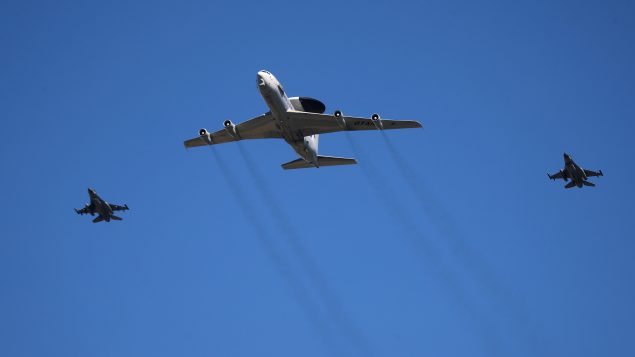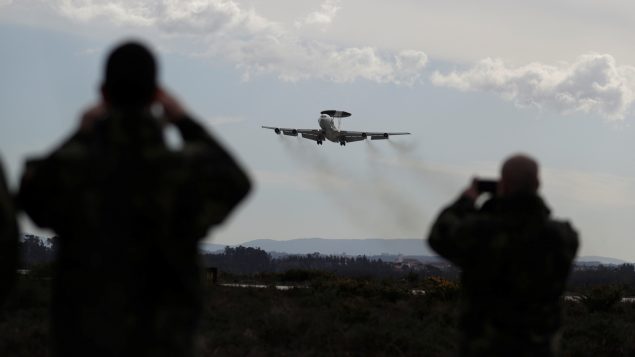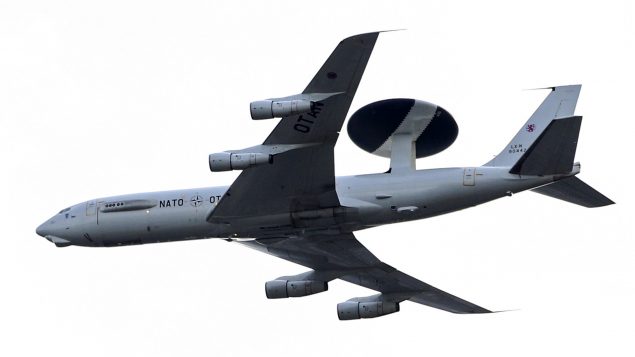Seven years after it withdrew from NATO’s Airborne Warning and Control System (AWACS) program, Ottawa has decided to rejoin the alliance’s aerial intelligence, surveillance, and reconnaissance program, Canada’s defence minister announced Wednesday.
The AWACS program was established by the United States in the late 1970s to keep a close watch over the Soviet Union’s military activities around the world. NATO has a fleet of 16 E-3A aircraft, modified Boeing 707s, giving the alliance abilities to conduct long-range aerial surveillance, and to command and control forces from the air.
With its distinctive disc-shaped radar dome mounted on the fuselage a single E-3A can constantly monitor the airspace within a radius of more than 400 kilometres and can relay information from its radar and sensors to ground-based, sea-based and airborne forces.
By using pulse-Doppler radar, an E-3A can find and track low- or high-flying aircraft and is able to give early warning of a potential adversary, which in NATO’s case is increasingly Russia.
The alliance has significantly increased the use of its AWACS operations over the former Warsaw Pact countries in Central and Eastern Europe that are now part of NATO and in the Baltics, where Canada is leading a multinational NATO battlegroup based in Latvia, defence officials said.

An AWACS aircraft accompanied by F-16 Fighting Falcon jets flies over the NATO headquarters during the opening ceremony of a NATO summit in Brussels, Belgium, May 25, 2017. (Kai Pfaffenbach/REUTERS)
While Canada doesn’t own any E-3A aircraft, it has in the past contributed several crews of about 16 people each to operate the aircraft, which have been used by the alliance in its recent operations over Afghanistan and Libya, said retired Gen. Tom Lawson.
In fact, Canada continues to provide crews to a separate U.S.-based AWACS program out of Tinker Air Force Base in Oklahoma, said Lawson who was deputy commander of the Royal Canadian Air Force (RCAF) when the decision was taken to remove Canadian crews from the NATO program in 2011, and chief of defence staff when the last Canadians came home in 2014.
The move to pull out of the NATO’s AWACS program in 2011 was meant to save the Department of National Defence about $90 million at the time, when following the 2008 financial crisis, the Conservative government of the day was looking for ways to slash its spending, Lawson said.
“There was a feeling on the part of the Canadian Armed Forces that the usefulness of the NATO AWACS might have been somewhat limited ironically by the fact that there were 14 or 15 different contributing nations,” Lawson said. “What was happening was when NATO wanted to deploy these things, often some of those nations would withdraw their crews.”

A NATO AWACS (Airborne Warning and Control Systems) aircraft approaches to the Air Base number 5 during the Real Thaw 2018 exercise in Monte Real, Portugal February 6, 2018. (Rafael Marchante/REUTERS)
But Russia’s annexation of Crimea and its involvement in supporting pro-Russian rebels in Ukraine in 2014 once again made the NATO’s AWACS program more relevant for intelligence, surveillance and reconnaissance, Lawson said.
The decision by the Liberal government signals Canada’s desire to demonstrate an increased support of NATO, likely partly in response to pressure from the Trump administration, Lawson said.
It means that Canadian air crews and their families will be going back to the NATO air base in Geilenkirchen Germany, near the border with the Netherlands, Lawson said.
“Canadians used to be the third largest contributor to the NATO AWACS program, we used to provide four full crews over there and also technicians to work on the aircraft, logisticians to run the program,” Lawson said.







For reasons beyond our control, and for an undetermined period of time, our comment section is now closed. However, our social networks remain open to your contributions.